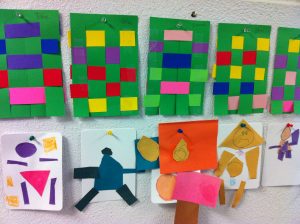 Now that daily routines are mostly established, our first fire drill is out of the way, and good-byes are getting easier, attention is shifting within the classrooms. As I walked through several rooms this past week, teachers have their notebooks out to document what children are doing in their classrooms. Some have individual sheets for each child to assess which shapes a child can draw. Others use yellow post-its to record anecdotal observations of how children use language and move about the room. Still others include student reflection as part of the assessment process. One of the most visually appealing artifacts was the cutting assessment self-portraits produced by the PreK students. In addition to giving information about their cutting skills, their work revealed much about their individual perceptions of themselves. Another visual assessment activity was a cutting and ordering assignment in the K-1 class. Students were asked to cut out capital letters from one sheet of paper and order them on a grid. This single assignment revealed children’s ability to focus, follow through, cut, use glue, order, match letters from an alphabet card, and determine directionality.
Now that daily routines are mostly established, our first fire drill is out of the way, and good-byes are getting easier, attention is shifting within the classrooms. As I walked through several rooms this past week, teachers have their notebooks out to document what children are doing in their classrooms. Some have individual sheets for each child to assess which shapes a child can draw. Others use yellow post-its to record anecdotal observations of how children use language and move about the room. Still others include student reflection as part of the assessment process. One of the most visually appealing artifacts was the cutting assessment self-portraits produced by the PreK students. In addition to giving information about their cutting skills, their work revealed much about their individual perceptions of themselves. Another visual assessment activity was a cutting and ordering assignment in the K-1 class. Students were asked to cut out capital letters from one sheet of paper and order them on a grid. This single assignment revealed children’s ability to focus, follow through, cut, use glue, order, match letters from an alphabet card, and determine directionality.
At this point in the year, teachers are using their observation skills to gather baseline data for each child’s development. These observations then become a starting point for curriculum development for the rest of the year. What I love about this process is how creatively the teachers weave practice of basic skills into the daily emergent curriculum. The same children who were assessed on how they hold a pencil earlier in the week, sat at the table with a potato peeler in hand, shaving off the skin of sweet potatoes from their garden. In the coming weeks, the same children will practice their cutting skills by trimming basil leaves off their stems. Toddler observations revealed use of sign language by several children. Teachers noted and planned future experiences to expand signing in their classroom. In the elementary classes, individual reading conferences reveal not only a child’s skill level, but also what they are interested in and which books hold their attention. Titles for upcoming lit studies are often selected based on this information.
As the year progresses, interests of children will be interwoven with specific skills practice to inform larger class content studies, such as the US presidents or the rainforest. Smaller studies are already emerging, inspired by books read in circle and creatures discovered on the playground. In time, studies of people, places, and topics both ordinary and exotic will overflow from Seed classrooms. This happens in meaningful ways because teachers, from the beginning, are aware of who their students are, what they need and what inspires their passion for learning.
